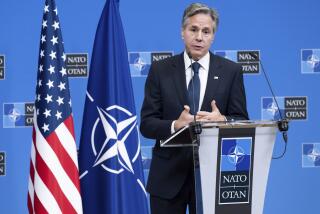What Do We Need and How Much? : Suddenly, defense theory seems more urgent
- Share via
When Washington and Moscow started talking peace, some military analysts warned that fending off regional wars might some day make the Cold War seem a piece of cake. With the confiscation of neighboring Kuwait by Iraqi troops this week, law-abiding nations must start taking the warning seriously.
Nuclear deterrence meant--and to a lesser extent still means--having the right number of nuclear missiles ready to retaliate after a surprise missile attack. Choosing the right number engaged some of the best strategic minds in the country, and even though it always seemed an imprecise science, it worked.
In theory, there is a right number of troops, tanks, ships and planes that will persuade tyrants like Iraq’s Saddam Hussein that grabbing off neighbors and their oil fields has more risks than benefits. In theory, the United States and its allies can develop a conventional deterrence that would work as well as strategic deterrence.
But, particularly in a region like the Middle East with its politics of suspicion and long history of religious and tribal hostility, practice is a long way from theory. There are severe limits to the number of locations where weapons and other supplies can be stashed (pre-positioned, as the Pentagon calls it) for use in an emergency, as they are in North Atlantic Treaty Organization countries. Moving quickly is more difficult in the Middle East because the instinct of royal families in the region always has been to bargain their way out of trouble rather than shoot their way out.
Finally, conventional deterrence will not only be more complicated than the Cold War variety but also more expensive. About 20% of the Pentagon budget goes to strategic forces.
There is an impulse to dismiss costs when the stakes are oil supplies for most of the industrial world, but costs cannot be ignored. Washington’s deficit is already big enough to damage the economy and is still growing.
Some members of Congress got part of the message of Kuwait last week--that there are still troublemakers in the world and the nation must not cut defenses too far or too fast. The rest of the message is that defense forces must match the threat these hoodlums pose. The next question is whether the B-2 and other weapons designed to fight a global nuclear war are the right weapons to deter regional aggression.
Nothing deterred Hussein this week. The nearest American aircraft carrier was several days from the scene of the invasion. A few thousand American troops conceivably could have reached Kuwait in days, but not enough to take on the 130,000 Iraqi soldiers who invaded Kuwait.
A practiced military planner could list the right number of troops, planes and weapons it would take to persuade a wholly reasonable commander of 130,000 soldiers he would lose if he started a fight. But theory is the easy part of conventional deterrence.
And the troops need not, and ought not, all be Americans. Where they should come from is where the planning gets tough. Even more difficult is negotiating permission to put them close enough to flash points to deter a dictator contemplating combat.
So there will be nothing easy about conventional deterrence. Fortunately, other nations with a stake in peace in the Middle East, including the Soviet Union, have rallied to President Bush’s call for what amounts to a quarantine of Iraq. That should buy time to adjust, if the luck of the industrial nations holds out. But Washington must use that time to start planning for fundamental shifts in its defense structure to deal with the new future--the future that suddenly seems a lot more urgent and menacing and a lot less theoretical and academic.
More to Read
Sign up for Essential California
The most important California stories and recommendations in your inbox every morning.
You may occasionally receive promotional content from the Los Angeles Times.













